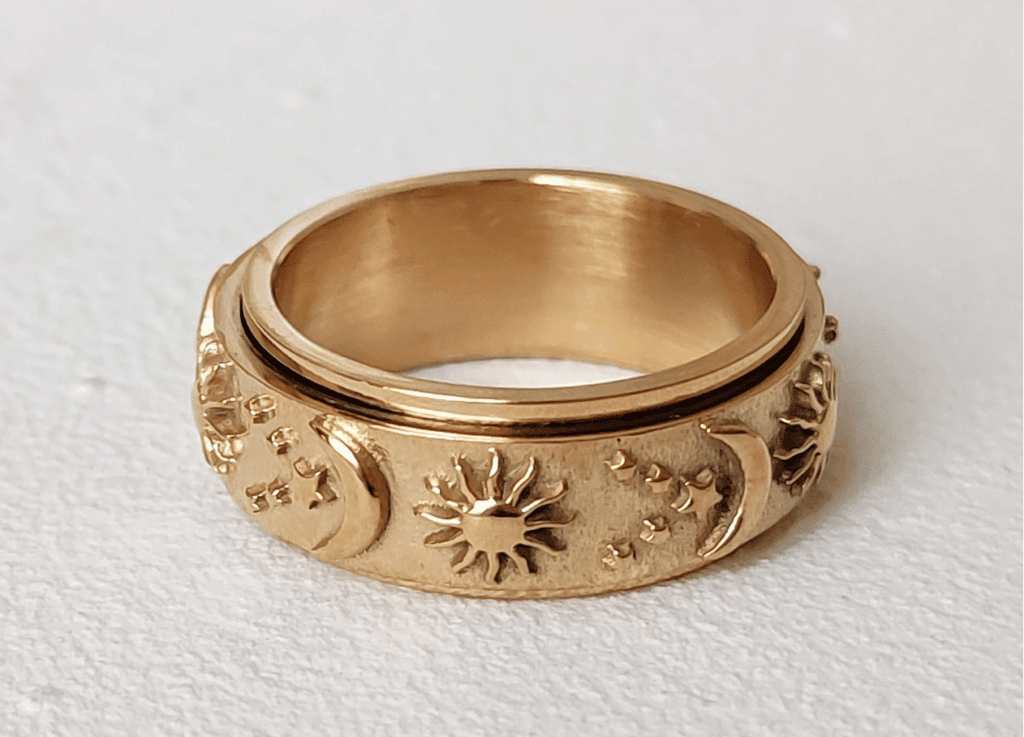(Image by KENZ via Etsy Shop)
Anxiety Rings (also referred to as worry rings or spinner rings) have been all the rage on social media lately, trending on TikTok, and since blowing up Instagram and Twitter. And while many of us can agree that these rings are beautiful and may enhance your personal style, we’re left asking ourselves if they can actually improve the quality of our mental health or are they just the latest fad on social media?
This blog post will break down what anxiety rings are, if they actually work, the pros and cons, and if they’re worth your hard-earned dollar.
What is an Anxiety Ring?
An anxiety ring is quite literally what it sounds like, a piece of jewelry you wear on your finger. They come in various shapes and sizes, sharing the same common goals- to help you focus, de-stress, and provide you with a sense of calmness. Anxiety rings are made of a variety of materials, such as stainless steel, titanium, and plastic. Some anxiety rings have gemstones, beads or crystals embedded in the band – there are even spinning rings that come with a built-in fidget spinner, and yes, they really spin!

(Image by Joyyjewelrystudio via Etsy Shop)
How people use these rings is subjective and depends on the right, but in most cases, people roll the beads or spin the band with their fingers.
The idea is that the ring will help redirect your focus and calm your nerves when you’re feeling anxious. Some ring wearers swear that the distraction helps relieve some of the symptoms of anxiety, such as racing thoughts, sweating, fidgeting, and heart palpitations.
Do Anxiety Rings and Fidget Rings Work?
Before diving into whether anxiety rings actually work, we must address what happens in the brain when we’re feeling anxious. This can be complex, so we will keep it simple.
Let’s say you have a big presentation coming up and you’re feeling anxious about it. The brain may encounter your anxiety as a threat (whether actual or perceived) and release a surge of chemicals, like cortisol, the body’s primary stress hormone, and norepinephrine, the chemical responsible for reacting to stress and anxiety. Without having an effective way to manage anxiety, the overactivity (also known as the flight or fight response) caused by the hormones can lead to impulses like playing with your hair, bouncing your knee, biting your nails, folding and unfolding your arms, clicking pens, or more severe physical and mental health conditions, such as panic attacks and phobias.
While there is no scientific evidence that anxiety rings work, anything you do that distracts you from thinking about what makes you anxious can help. For example, let’s look at an alternative toy like the stress ball. A study revealed that squeezing a stress ball during surgery can reduce anxiety by 18% and pain by 22%, demonstrating that this old practice can be effective.
However, many mental health professionals caution that anxiety rings should not be considered a replacement for therapy or medication, as they’re designed for short-term relief rather than addressing the root cause of anxiety.
What are the Pros and Cons of Anxiety Rings and Fidget Rings?
There are both pros and cons to using anxiety rings. The main pro is that they are a non-invasive way to help you manage your anxiety, having a self-soothing effect. They are also relatively inexpensive, making them more enticing to purchase. You can easily find a variety of anxiety rings on Amazon for approximately $20 CAD.
The main con of anxiety rings is that there is no scientific evidence to support the claim that they help relieve anxiety. Additionally, they don’t address the underlying causes of anxiety and it’s been documented that they can be distracting to those wearing them or to others around.
Are Anxiety Rings and Fidget Rings Worth the Money?
Since anxiety rings are not currently backed by scientific evidence, whether they have value or not is difficult to answer. Some ring wearers could tendentially justify their worth based on anesthetics and affordability.
An anxiety ring may be a fantastic diversion device for individuals with a long-term condition such as ADHD, where sitting still might be difficult. However, it’s important to note that this behaviour reflects coping skills rather than a cure. In other words, relying on anxiety rings becomes a safety-seeking behaviour for persons seeking to manage ongoing anxiety. It also means that anxious people may become dependent on them to provide short-term comfort. However, it does little to help these individuals overcome their issues in the long term.
Using an anxiety ring alone does not tackle the root cause of anxiety.
Other Lifestyle Changes That Can Help Manage Anxiety
With 1 in 5 people in Canada experiencing a mental health problem or illness, it’s crucial to consider that anxiety is different for everyone, and it’s certainly not a one-size-fits-all approach.
There are several other ways that have been scientifically proven to help reduce and manage stress & anxiety. Some alternatives for improving mental health include:
- Therapy – Online therapy is an excellent option for people feeling overwhelmed by life’s challenges. Talking to a licensed therapist can help you to understand your anxiety and develop healthy coping skills.
- Social Support – It’s frightening to expose oneself to others; there’s no doubt about that. However, opening up to friends or family may allow you to receive more emotional support from your social network.
- Physical Activity – Regularly exercising releases those “feel good” brain chemicals, also known as endorphins, to improve your mood. Exercising can be a great distraction and is proven to help people get away from their depressive and anxious thinking cycles.
- Healthy Eating – Developing nutritional strategies for a well-balanced diet can improve your mood and energy, increase confidence, reduce mild depression or anxiety, and can help you take a bite out of life’s hardships.
- Medication – There are many medication options available that can help manage anxiety. It’s important to always seek advice from a medical professional.
- Deep Breathing – Breathing exercises can almost instantly help slow down your heart rate and calm your nervous system.
- Meditation & Yoga – Relaxation exercises can aid in the release of stress and anxiety, which brings both the body and mind to sense peace and comfort.
- Self-Care – Take the opportunity to focus on yourself. Find something that makes you feel good about yourself, and repeat.
- Sleep – Most adults need 7 to 9 hours, but excessive worry and fear can disrupt sleep.
- Try having a warm bath, reducing caffeine, avoid drinking alcohol, and put down the screen at least one hour before bedtime.
When to See a Therapist
Everyone has behaviours in their life that they’d like to change, which requires determination and practice. However, if you’re struggling to cope with your anxiety on a day-to-day basis, it may be time to see a mental health professional. Here are some signs you might need a therapist:
- Feeling Overwhelmed – You regularly feel like you have too much to accomplish or too many issues on your plate. Anxiety might make you believe you can’t relax or even breathe.
- Fatigue – It’s easy to overlook the signs of tiredness when you’re stressed and exhausted. This physical symptom is frequently caused by or linked to mental health problems. You might sleep more than usual or have difficulty getting out of bed in the morning due to fatigue.
- Anger – Anger is a normal feeling and isn’t necessarily harmful. However, when anger doesn’t pass, when it is far more severe than the problem, or when it causes violent or potentially dangerous actions, seeking help to cope with anger will be beneficial.
- Panic Attacks – A panic attack is an intense feeling of fear, terror, or anxiety that comes on suddenly and without warning. Panic attacks can be very frightening and may include a pounding heart, sweating, shaking, shortness of breath, hot flashes, or lightheadedness.
- Worry or intrusive thoughts. It’s natural to worry about things from time to time, but when worry consumes a substantial amount of your day or causes physical symptoms, therapy can help you cope.
- Apathy – Losing interest in usual activities, the world around you, or life in general, can indicate mental health issues like depression or anxiety.
- Hopelessness – Losing hope, motivation, or believing you have no future, might be signs of depression or another mental illness. It’s natural to feel hopeless from time to time, particularly after a period of difficulty, but when it continues for too long, it can lead to thoughts of suicide.
You’re Not Alone – Support is always available
Anxiety rings have gained popularity on TikTok, but not everything seen on social media works so make sure you do your research before making an investment. While anxiety rings may calm you down in those stressful moments, you may need further help because anxiety rings are not the cure.
Thankfully, with the tools and methods accessible to you, such as those outlined in this post, along with the help of others, your mental health can improve. Online therapy can help you discover strategies for dealing with stress and anxiety in both the short and long term, allowing you to concentrate on enjoying life to the fullest. The wonderful thing is that finding a therapist who knows how to treat anxiety is more accessible than ever.
Focus Mental Wellness helps Canadians match and connect with licensed therapists online across Canada. Book an appointment today to discover how Focus can assist you in managing your anxiety and stress, so you can start living a happy and healthy life!



